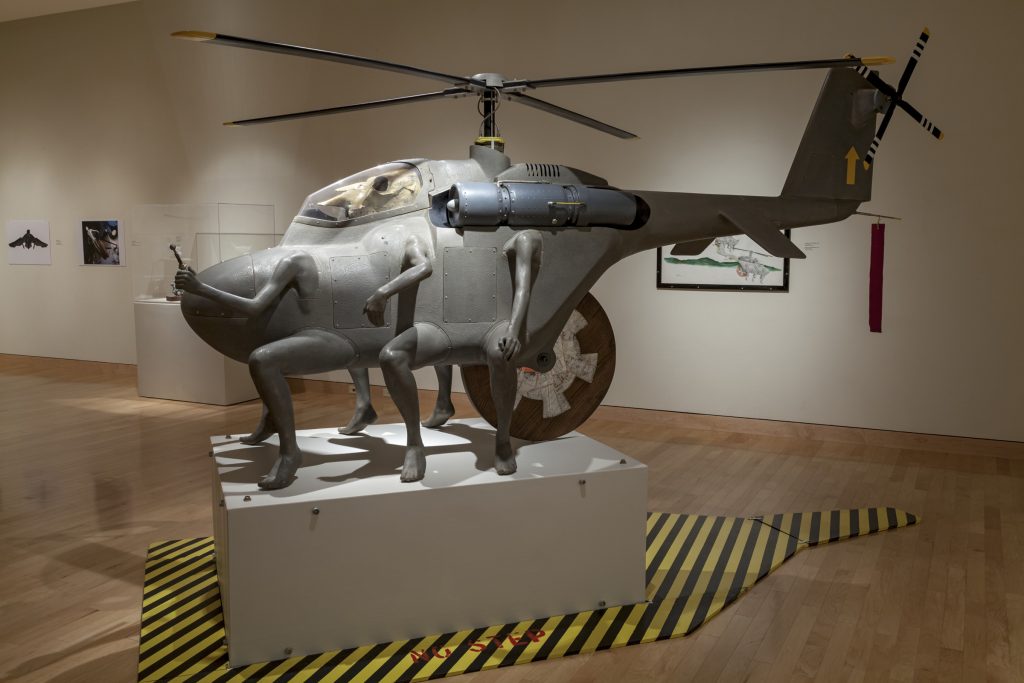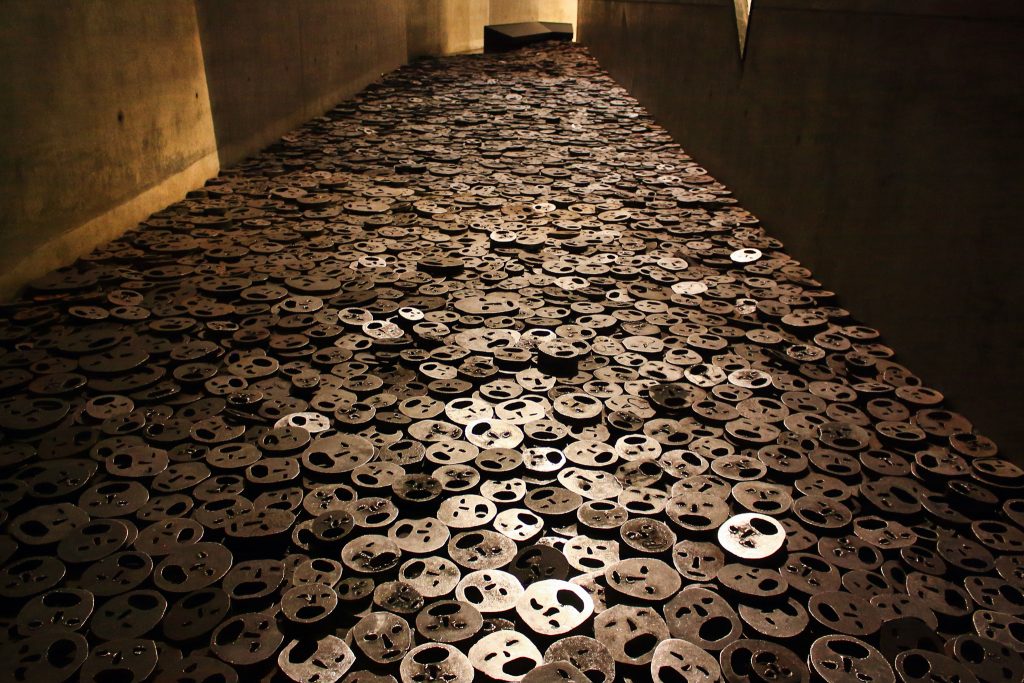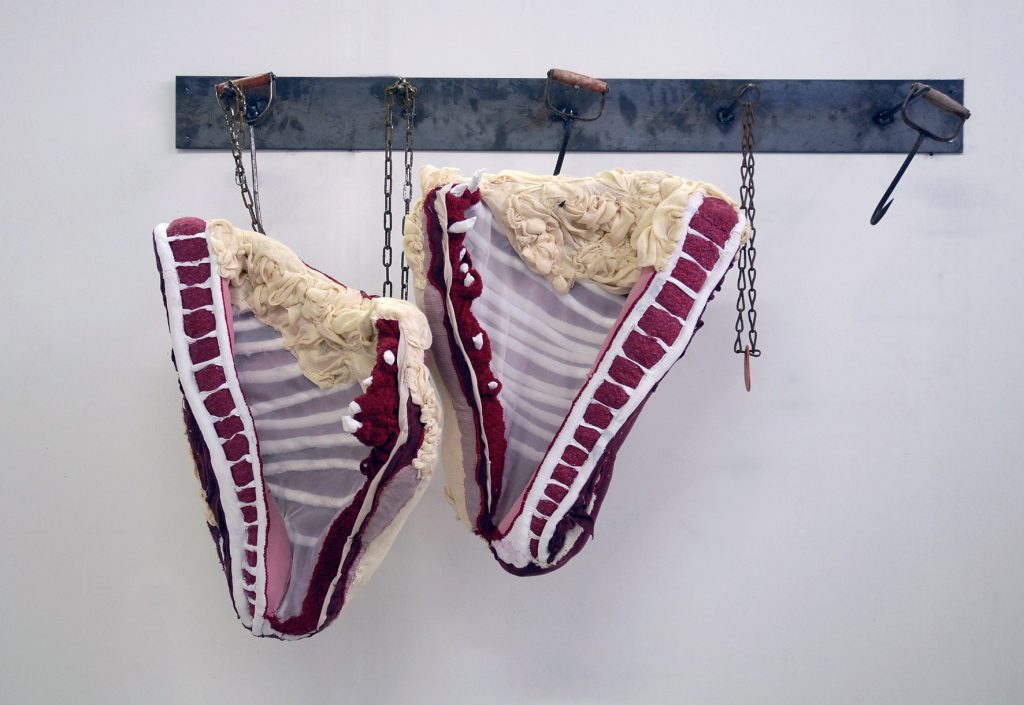In: installation

Don Bonham | Twentieth Century Technology Utilized by Third World Mentality, 1993
September 9, 2022Don Bonham | Twentieth Century Technology Utilized by Third World Mentality, 1993
Don Bonham (1940 – 2014) was a sculptor who produced monumental works that intersect with classical ideas about art and also incorporated contemporary references – especially as pertains to industry and technology. His work alternates between humour and a disturbing – yet attractive – aesthetic that reflects back on a larger society, especially in terms of how often any new technological advance is met with the brutal inquiry of whether “Can this make killing less of a hassle?” (Sadly, the second blunt question is, “Can I have sex with it?”). If you think I’m wrong, consider other works by Bonham that would please J.G. Ballard as three dimensional iterations of some of Phoebe Gloeckner‘s illustrations to his texts…or horrify him, edit as you will.
Don’t criticize Bonham’s presumed priapism and the implicit male gaze in his work: an era gets the artwork it merits. His industrial works often openly acknowledged and built upon the fetishization of object that was a continuation of a fetishization of the female body. His works are always seductive and well executed, if initially unsettling.
In his own words: “The gap between human and machine is constantly shrinking. Are we to become more like machines, or machines more like us? The creators of technology have imbued machines with human characteristics, and this tendency is creating a more hospitable environment for their acceptance by society. As an artist I am only enlarging upon this concept.”
Years ago, a fine film critic spoke of how futurism, in cinema, was either a clean, antiseptic space, like an Apple store, or more like Blade Runner, and broken, dirty and more part of an industrial gothic aesthetic. Bonham falls within the latter.
I have been accused of being somewhat ‘subjective’ as a reviewer, often relying upon ‘inappropriate’ sources and considerations when engaging with artwork. This bemuses me, and entertains me even more when I consider that a motivation for featuring a work by Bonham is the rather disrespectful – though typical of the vagaries of institutions that claim to protect and nurture culture – decision by McIntosh Gallery, at the University of Western, to de accession one of his works from their collection. Curator, writer and gallerist Terry Graff has been working against that, and you can see his efforts – and learn more about Bonham and his legacy – at Graff’s social media.
But in looking at Bonham’s sculpture here (and many of his similar works that meld, merge and mash up humanity and machine, with a sense of militarism that is almost inappropriately amusing and intersects with black humour) a Vietnam era anti – war anthem from the 1960s comes to mind. This is fitting, as Bonham came to Canada during the period when many men from the United States were fleeing their country, opposed to the war there. However, “Bonham enlisted in the U.S. Marine Corps and served in an elite Recon unit in Southeast Asia. After six and a half years, he was honorably discharged to enter the University of Oklahoma as an Art History Major. He left university before graduating and worked in Detroit on a Ford assembly line before moving, in 1968, to London, Ontario, where he discovered a dynamic arts community that reinforced his decision to pursue a career as a visual artist.” (from a retrospective of Bonham’s artwork at The Beaverbrook Art Gallery)
The song Sky Pilot by The Animals is as confrontational as Bonham’s Twentieth Century Technology Utilized by Third World Mentality, and for its time was surely controversial: and it’s necessary to include the print below that Bonham produced, of his modified – or realized – helicopters swooping down, mimicking that infamous scene where the ‘righteous’ decimate a village from Francis Ford Coppola’s Apocalypse Now. Death rides a pale horse, a mechanized cyborg that’s surely a descendant of Albert Pinkham Ryder’s The Race Track (Death on a Pale Horse), coming down from the sky….
Regionalism has both defined – and deformed – Canadian art and Canadian art history (and is arguably why Bonham’s work is being so disrespected by the University of Western. Graff is more erudite and informed on this front than I). But regionalism is also the lens through which I respond to the terms of ‘First World’ or ‘Third World’ (cited in the title of this work) which seem as archaic at times as ‘Cold War’ (an epoch I had to explain to students, when I used to teach at a university, and let’s remember that the ‘Second World’ was the Communist Bloc, and the most avowed communist country now is definitely ‘open for business’…).
Bluntly, there are those who have and those who have not, and the tools at hand are used to enhance the former and demean the latter: it is the ‘order of things’, in the era of late capitalist modernism (to quote Jameson) or, as I like to call it, late modernist capitalism. Trinh T. Minh-ha (a Vietnamese – so she has an intimate understanding of the construction of history, as pertains to colonization / imperialism – filmmaker, writer, literary theorist, composer, and professor) famously wrote that “there is a third world in every first world, and vice-versa.” Bonham – and myself, initially – spoke of Vietnam. But you’re more likely to see a third world in your own city, overseen and monitored by a machine not unlike this sculpture (with the excessive militarization of police departments), in the skies over Detroit or Cleveland or Baltimore…or my own site of Niagara, or my previous space of Saskatoon, with tent cities and other ‘undesirables’, too often given harm over help, unlike other more harmful groups that squat, rife with sedition and fascist symbols….
Many thanks to Terry Graff for support, and conversations, that helped define this essay. Much more about Bonham’s life and artwork can be seen at Graff’s social media feed (there is also a petition to make Western reverse their decision here) and Bonham was a past Artist You Need To Know, in AIH Studios’ ongoing series. That can be enjoyed here.
~ Bart Gazzola
Read More
Menashe Kadisman | Shalechet (Fallen Leaves), 1997 – 2001
August 19, 2022Menashe Kadishman | Shalechet (Fallen Leaves), 1997 – 2001
Installation, Jewish Museum, Berlin
When we were young, we wanted our art to change the world. But when Hitler bombed Guernica, did Picasso’s painting have any effect? I thought that maybe some things of mine could do good. My sculptures didn’t change the war in Lebanon. Maybe art is not about changing anything. It’s about telling you reality. (Menashe Kadishman)
I will admit that I rely upon the term ‘contested narratives’ a bit too much: but when confronted with Kadishman’s installation, where his own personal history (as the child of two committed Zionists, in the early twentieth century) and larger tropes intersect, contradict and in some ways twist and transform in a manner that is more apropos to a fictional story than our expectations of ‘reality’, I feel I have no recourse.
Kadishman’s installation is “primarily associated with the Shoah (the Holocaust) [but] it holds a universal message against violence and human suffering. Kadishman himself notes that the work can relate to different tragedies such as World War I and Hiroshima. In part, Shalechet derives its meaning from the context of its presentation. For example, it took on a new meaning in 2018, when it was exhibited at the Memorial Hall dedicated to the victims of the Nanjing massacre in China.” (I include a link as this horror is lesser known, in the cacophony of savagery that is human history, like the many – repetitive, interchangeable, eternal – ‘faces’ silently wailing on the floor of Shalechet, growing old and rusting and still unheard….)
Read more of Gazzola’s response to this work here.
Read More
War Map Dress Trilogy | Carolyn Wren, 2003-2004
June 30, 2022Carolyn Wren | War Map Dress Trilogy, 2003-2004
(lino blocks, hand-printed on Dupont silk, thread, zippers, mannequins, model airplanes, black paint)
I encountered these towering figures during Wren’s retrospective exhibition Task At Hand at the now shuttered Rodman Hall Art Centre several years ago. Standing in the large back gallery space, the three female figures dominated the room, with the flow of their dresses spilling out from them, pooling around them on the gallery floor.
Visiting this show numerous times, I found that different ideas came to the fore with different interactions, from initial wonder to later, more critical consideration. When an artist / writer friend, Anna Szaflarski, visiting Niagara, came with me on one occasion, she saw the works in a very different light than I had, initially. Unsurprising, really, as when Szaflarski and I first met, it was around her exhibition at NAC about the historical detritus – or lack thereof – of General Motors’ legacy in St. Catharines, and I believe we connected over an irreverent honesty about history, the region, and the intersecting if conflicting stories of the place we both grew up in….
My reading had been informed by Wren’s own words, which are as follows: The ingenuity of Christopher Clayton Hutton’s invention of silk maps for the British Royal Air Force during World War II enabled pilots to use lightweight and durable maps to help them reach safety in times of crisis, and inspired women to make dresses out of the silk maps as their men returned home. The maps used by Wren in the dresses were made in Europe by the Canadian government and shipped to Canada for families to follow the movements of their loved ones fighting in the war. Alluding to multiple layers of symbolism of the landscape in relation to the body, and reflecting on war and the politics of Feminism (viewpoint, memory, and identity), The War Map Dress Trilogy is more about history, location, distances, than it is about terrain.
I talk a lot about ‘contested narratives’: but this story, this Curator’s Pick is very much about that. Szaflarski – a former student of Wren’s, as Caroline taught in Niagara for some time, and helped shape a few generations of artists and art appreciators – upon seeing the exhibition, and these ‘women’, spoke more in a manner reminiscent of Barbara Kruger’s famous – and still relevant – artwork that declares that YOUR BODY IS A BATTLEGROUND. These battlefield maps, on dresses hanging on mannequins without heads or hands, look more like spaces to be attacked, or acted upon, utterly passive and just victims…. (“Afterwards she could not walk for a week, her feet would not fit into her shoes, they were too swollen. It was the feet they’d do, for a first offence. They used steel cables, frayed at the ends. After that the hands. They didn’t care what they did to your feet and hands, even if it was permanent. Remember, said Aunt Lydia. For our purposes your feet and your hands are not essential.” Margaret Atwood, A Handmaid’s Tale).
More of Carolyn Wren’s work can be seen here. A recent curatorial project of mine, based upon the Rodman Hall Collection, and which included Wren’s work, can be seen here.
Photographs are by Sandy Fairbairn and the author.
~ Bart Gazzola
Read More
TAMARA KOSTIANOVSKY | ACTUS REUS
June 17, 2022Tamara Kostianovsky | Actus Reus
I am afraid the good woman did not realize how difficult it is to cut up a body, never having done so herself. (Margaret Atwood, Alias Grace)
To the Puritan all things are impure, as somebody says. (D.H. Lawrence, Sketches of Etruscan Places)
Tamara Kostianovsky’s artworks are disquieting; that is meant as praise. What her sculptures in the body of work titled Actus Reus – both specific elements and the larger installations of multiple components – do is allude, and we do the rest. What we initially ‘think’ we’re looking at is not at all what we’re truly observing. An initial revulsion turns to seduction, and we find ourselves drawn in by both the formal attraction as well as the conceptual fracture that only makes her work more enticing.
It’s almost appropriate, then, that one of the works that comprises Actus Reus is titled Abnegation (which means “the act of renouncing or rejecting something”); or that the name of the series itself is a ‘criminal’ legal term. Actus Reus is “sometimes called the external element or the objective element of a crime….the Latin term for the “guilty act” which, when proved beyond a reasonable doubt in combination with the mens rea, “guilty mind”, produces criminal liability in the common law−based criminal law jurisdictions of numerous countries….” There is almost a culpability in our own interactions with these artworks…..
Other works in this series – What It Once Was (2011), One and a Half (2008), Bound (2008), Venus (2011), Elegy (2009) – all leave the viewer feeling as though they’re looking upon – and enjoying gazing upon, devouring with their eyes – something that is forbidden, not meant to be seen, and definitely not be enjoyed, as though illicitly consuming visual pleasure from them….
Before I delve further into my interpretations of Kostianovsky’s work, her statement is as follows: The discovery of a world concealed behind the skin took form in my adolescence while working at a surgeon’s office, where veins exploded into waterfalls, cut ligaments set free the muscles they once contained, and chunks of fat poured over tissues of various colors and textures. A fascination with these encounters put the body at the center of my work, allowing me to use this imagery to reflect on consumption, ecology, and the voracious needs of the body.
Read more of Bart Gazzola’s thoughts on this work here.
Read More
Recent Comments